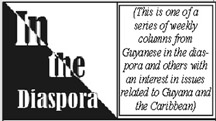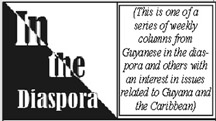 Susana Hurlich is a Canadian anthropologist, researcher and consultant who has lived and worked for the past 26 years in Cuba. Before that she worked for many years in Southern Africa, especially in Angola and Namibia.
Susana Hurlich is a Canadian anthropologist, researcher and consultant who has lived and worked for the past 26 years in Cuba. Before that she worked for many years in Southern Africa, especially in Angola and Namibia.
Editor’s Note: Thanks to Keith Ellis, Jamaican-Canadian Professor Emeritus at the University of Toronto who has been involved in Cuban solidarity work since 1959 and Elizabeth Hill, one of the founding members of the Canadian-Cuban Friendship Association, for helping to share this report from the ground in Cuba, where Hurricane Irma made landfall as a category five storm.
On September 14th, the electricity returned to my little part of Havana. Five full days without electricity and all I can think of are the many people both in Havana and around the country who are still without light as well as, in many cases, without water and/or gas or something else with which to cook.
Hurricane Irma was devastating for Cuba. I was here during the Storm of the Century, in 1993, which was considered to be one of the very worst hurricanes to hit Cuba. But Irma already has the reputation of having surpassed that storm. I’m sure you’ve been reading about the massive damage done to the national energy system, agriculture, education, housing and nature herself. The national grid was completely knocked out and in many places is still seriously affected. The Antonio Guiteras thermoelectric plant in Matanzas, which if I remember correctly supplies 25% of the country’s energy, suffered damage beyond imagination. Even a wave breaker consisting of immense 50-ton cement blocks was completely dismantled and moved by the fury of the storm’s winds.
Here in Havana, the electricity was shut off on Friday the 8th at about noon. For those of us with battery-operated radios – and batteries! – we were able to hear the regular partes – the constant up-to-the-minute weather reports from the Meteorological Institute located here in Havana, on top of a hill in Casablanca across the bay from Habana Vieja. Our round-the-clock source of news was the historic and well-known Radio Rebelde, which provided constant orientations and updates from Cuba’s Civil Defense system on a national, provincial and municipal level. We got detailed information on what was happening all around the country as Irma made its way from Baracoa in the far eastern province of Guantanamo to northern coastal communities in the far western province of Pinar del Rio.
Most serious, there were ten deaths… an unusually high number for Cuba. Three of these deaths happened because individuals refused to follow the advice of Civil Defense personnel who wanted them to evacuate their homes which were considered to be either unsafe or located in unsafe areas. A tragic loss, no matter how one dies. What is most important, though, is that none of these ten deaths happened because people were abandoned or marginalized by society or in the “forgotten other” category. In Cuba, all lives count and regardless of the reason of death, the country and its population laments their loss. This is a testimony not only to the quality of Cuban’s Civil Defense system but to the dominant values of the country and its people as a whole.
In my neighbourhood of Vedado, much of what happened is typical of what happened elsewhere in the city. People who lived in the “lowlands” – those areas on the same level as the Malecón or seawall – were flooded. Many had already evacuated their homes. Others, living at ground level, were rescued by boat. Waves reached nine to twelve metres all along Havana’s coastline and all along the coastline, serious flooding occurred. The tunnel located at the mouth of Havana Bay and which provides the main link between Habana Vieja and the Playa del Este (eastern beaches) area was completed flooded as was the tunnel located on 5th Avenue. Trees were knocked down everywhere. Just in my block alone, a huge double-trunked tree keeled over at ground level, with one thick trunk falling backwards on top of a home under reconstruction, knocking down the four thick columns that hold up the veranda roof, and the other thick trunk falling across the street, completely blocking the way. Just up the street another large tree fell onto another home. Thick branches were wrenched off large trees and leaves were burnt by the wind everywhere. During the night of the hurricane itself – Saturday – it was impossible for anyone to sleep not just because of the pounding rains and howling winds, but also because anything on top of people’s roofs became dangerous whistling projectiles. One could hear glass shards flying around as the occasional window got blasted by the wind and broke.
Those of us who still had phones that worked or, more commonly, cell phones that still had their charge, spent most of the night sending and receiving messages to friends, family and loved ones all across the country. It’s impossible to feel alone in Cuba, especially during a crisis. When the hurricane was in the east, I was calling Baracoa and San Antonio del Sur in Guantanamo and the city of Holguin. When it was in central Cuba, I was calling Abreus in Cienfuegos… and elsewhere as well. When it was here in Havana, I was receiving non-stop calls from all these locations. And everyone else who could was doing the same, calling here and there, making sure people were OK, giving support and advice. That incredibly vibrant human network that so typifies Cuba and is the reason that so many people who visit from abroad continue to come back again and again. It’s palpable – and it’s very comforting when there’s a massive hurricane barrelling down upon your community.
Note: When thinking of gifts you might bring your Cuban friends when you’re visiting, be sure to include lots of AA batteries. That’s what keeps most of our battery-run radios (and flashlights) going and there’s a shortage of batteries in the country, especially long-lasting ones. Just before the hurricane hit, I had given several of my neighbours some AA batteries for their radios (and some of them gave me space in their deep freezers for some of my foodstuffs).
There is so much to say… all I can do at the moment is just provide a few glimpses.
Impressive is not only Cuba’s Civil Defense system, about which I’ve written a lot during past hurricanes, but the rapidity and wholeheartedness – and inclusiveness (everyone benefits, not just a privileged few) – with which Cuba enters the period of reconstruction as soon as the hurricane has past. Keep in mind that the country’s national energy grid suffered so much damage that the country was in the midst of a national blackout. In addition to infrastructural damage, so many trees had fallen that along with posts and cables being knocked down, roads were blocked as well. The first need, though, was water – that precious liquid – especially drinking water. In Havana, for instance, special points providing potable water and some basic food stuffs were set up in areas near the coastline that had suffered serious inundations. Brigades worked around the clock to clear the roads, or at least to cut a way through the trunks and branches that will be collected later on. This work is still going on. Transformers are still being repaired and as a zone is completed, it gets electricity. My neighbourhood finally received electricity late yesterday afternoon. Parts of Marianao and San Miguel del Padron municipalities received electricity the day before. Parts of Habana Vieja got electricity within a day or two of Irma’s passage as their electrical cables are underground. Other areas are still waiting for the lights to go on…
Throughout this week, students have been returning to their classes at schools and other educational centres around the country, except for those (many) schools that have been seriously damaged or which are still being used as evacuation centres. Clinics and hospitals of course are a priority, but even they have had serious impacts. For instance, the internationally known Clinica Central Ciro Garcia here in Havana has a shortage of fuel, so the priority for what fuel they do have is given to the surgical wards while physical rehabilitation has been temporarily suspended.
Transport is slowly coming back to normal. Whereas just last Monday and Tuesday, it was virtually impossible to get anywhere in the city, buses and taxis are now running again, inter-provincial buses are back on schedule, and water transport between the mainland and Isla de la Juventud is again functioning as is the country’s airline. But there are shortages of gasoline.
Before I close, I want to say something about the animals. So little is written about the animals. As part of its evacuation plan, Cuba also tries to give protection to its productive animals. If located in lowlands and/or areas susceptible to flooding, livestock are moved to higher grounds. Pigs and poultry are brought indoors. Do you know that when out in the open, cattle won’t seek shelter under trees but instead will huddle in the open, with the adults forming a circle butt-end out and the youngsters and calves on the inside? But they suffer. They all suffer. When pigs get terrified, as they often do from the howling winds and roofing sheets that fly off, they’ll often resort to attacking each other. As for poultry, you may think that a chicken which lays eggs before a storm will continue to lay eggs right after the storm has passed. But it doesn’t work like that. Poultry suffers psychologically from hurricanes and it usually takes three months for them to recover enough and feel stable enough to once again lay eggs. Most seriously, the water all these animals are drinking, especially those that live “on the range,” is contaminated after hurricanes from all the polluting runoffs that carry so much in its wake. The result is that they suffer from parasites – and this affects their reproductive health as well as the quality of food they eventually provide to human beings. Often international aid thinks of human needs. Important, without question. But we should also keep in mind some of the key non-human animal needs such as anti-parasitics. In Guantanamo, for instance, when anti-parasitics are received, the provincial Council of Veterinary Science makes a point to include veterinary students in the administration of anti-parasitics to livestock as part of their practical training. A double benefit, for the animals as well as for the preparation of future veterinarians.
I find it encouraging, indeed inspiring, that a country like Cuba – a poor country economically – is able to show such important concrete results so soon after a massive hurricane. Obviously Cuba can’t do it alone, not with the extent of damage that has been sustained in so many key sectors. But time and time again, Cuba shows that when punched and seemingly down, the country gets right back up on its feet and keeps fighting. It makes one realize that the key isn’t really wealth as such, but the political will of a country and the confidence of the people that they won’t be forgotten. When there’s the will to do, so much can be done with so little.





